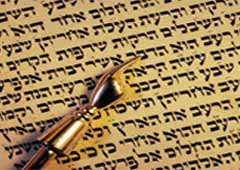Ki Tissa: Those Shining Horns

Exodus 30:11–34:35
At the very end of this week's portion, Moses descends from Mount Sinai with the replacement set of the two tablets of the Law. As the Torah puts it, "Moses knew not that the skin of his face karan while He talked with him" (Exodus 34:29). The 400-year-old King James Version, like just about every other English translation, renders karan as "shone" (the exceptions give "radiate" or "beam"). But the towering Renaissance artist Michelangelo, under the likely influence of the Latin Vulgate, took the Hebrew term literally, as signifying horns (keren), and in his famous sculpture duly placed a pair of them atop the head of Moses.
Curiously, a similar sentiment occurs among some medieval exegetes. Rashi (1040–1105) says: "It signifies horns, because the light shone and protruded like horns." Hiwi al-Balkhi, a 9th-century gnostic much disliked by traditional commentators, diagnoses Moses' condition as the result of dehydration, brought on by forty days on the mountaintop with neither food nor water. By contrast, Rashi's grandson Rashbam (Samuel ben Meir, 1085–1158) dismisses such interpretations caustically—"Whoever likens it to the horns of a ram is foolish"—a rejection in which he is joined by Abraham ibn Ezra (1090–1164).
Rashi's interpretation, however, was followed by Nicholas Lyra, an influential 14th-century Franciscan exegete, and it became the predominant one in Latin Christianity. In The Horned Moses in Medieval Art and Thought (1970), Ruth Melinkoff observes that, by contrast, the pictorial horns are entirely absent from the art of the Eastern Church, a circumstance she attributes to the latter's reliance on the Greek tradition of the Septuagint rather than the Latin tradition of the Vulgate.
"And when Moses had finished speaking with them, he put a veil over his face" (34:33). On the assumption that karan means to shine, what purpose is served by the shining, and why does Moses appear to thwart it by wearing a veil? The answers lie in a comparison of this second descent with Moses' first one, carrying the original tablets. In that case, the people, having seen the thunder and lightning, fall back and beseech Moses to speak to them in lieu of God—"lest we die." Just as the initial revelation was accompanied by a fearsome light, so now is the second; as Nahum Sarna comments, Moses' "radiance authenticates the Source of the message." In representing the divine—receiving the word of God and delivering it to Israel—he shines with a fearsome light; when he has "finished speaking" and is ready to deal with earthly matters, he deliberately masks it.
Earlier in this week's portion, we encounter the episode of the golden calf. It begins when the people, fearful of their leader's protracted absence atop Mount Sinai, approach Aaron, saying, "For that man, Moses . . . we know not what has happened to him" (32:2). The telltale phrase, "that man, Moses," recurs significantly in the book of Numbers: "That man, Moses, was more humble than any person on the face of the earth" (12:3). Moses' ability to subordinate himself entirely to the will of God is what makes him, on occasion, radiant. His readiness to dampen this radiance in order to interact with his fellow Israelites is what makes him "that man" and earns him the epithet rabbeinu, our teacher, which he retains until today.
Moshe Sokolow is professor of Jewish education at the Azrieli Graduate School of Yeshiva University.
Comments are closed for this article.




